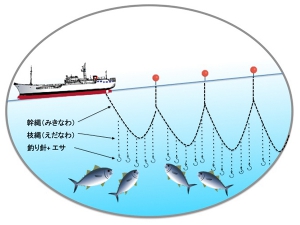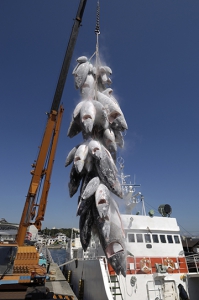目次
1. Historic Longline Fishing: Its Pros and Cons
Historic Fishing Methods of Japan
Longline fishing is a fishing method for catching fish like Tuna using longline fishing gear.
Tuna longline fishing has an especially long tradition that started in Furamura (Tateyama, Chiba in Japan) in the mid 18 century during the Edo era.
Nowadays, tuna longline fishing extends to Asia and a lot of countries in the world from Japan. With the global tuna sashimi market expanding its demand, the fishing methods used is expanding globally.
Surprisingly Long, Main Fishing Line
What is ‘Hae-Nawa (longline in Japanese)’? Well, ‘Hae-Nawa’ is a system for setting up the bait and the fishhooks on the top of each short length of line called ‘Eda-Nawa (branch lines)’, which connect evenly on the long length of line called ‘Miki-Nawa (main line)’
The length of main line is from a few 100 m to over 150 km as the longest line, the length between the branch lines (which is between the bait sections on the fishhooks) is approximately 50 m.
Setting the longline hook rig up is called as ‘Tou-Nawa (roping line)’ and pulling them all out is known as ‘Age-Nawa (pulling line).’
Pros and Cons of Longline
Purse seine fishing using a net has a risk of collecting non-targeted fish, but longline fishing collects only the targeted fish. Purse seine fishing catches fish in an ‘area’, while longline catches fish in ‘a pinned point’. Basically, because the amount of fish caught is easy to control, it’s said that longline fishing is fishing resources friendly. However, on the other hand, large birds like albatrosses that eat dead squid floating on the sea could eat the fishing hooks mistakenly or sea turtles could eat the set fish hooks in the water thinking it’s a fish.
Because of those possible harms, the technology and the ideas have been improving to avoid fishing the non-targeted sea animals.
2. Realities of Hard Ocean-going Longline Tuna Fisheries
Classification of longline tuna fishing
Longline tuna fishing is classified into three parts which are the distant sea because of the size of the ships (more than 120 tons), the coastal sea (from 10 tons up to 120 tons) and the small area (below 10 tons).
In Japan, 70 % of the amount of fish caught by the longline tuna fishing is by the big ships.
Pelagic Longline Tuna Fishing, Which Takes More Than 1 Year to Voyage
This fishing style is on a big ship so the main line for fishing is over 100 to 200 km believe it or not, the number of the branch lines is also huge at approx. over 3,000 ropes. It’s a long way to come back once departed, the period of voyage is more than one year (average 380 days), and operation days are an average of 250 days a year. During the time of going to the fishing grounds from Japan, the fishing gear is maintained, once the operation starts it’s usually to call at a port overseas once every three months to resupply with fuel and for the crew to rest. The numbers of crew members are 20 to 25 people. Due to the small manpower, people of various nationalities have been employed a lot too recently.
Hard Work of Throwing and Pulling Lines and Freezer Technology
One operation set of the faraway longline tuna fishing is to throw lines (put bait on the hook and throw it in the sea) once a day and pull the line (landing fish). This work goes on for a long time, and it is very hard work both physically and mentally.
The work starts at about four am in the morning. They attach floats on 100 to 150 km of main line; floats are buoys and also act as landmarks and allow the lines to float. Also, they set bait on the hooks on approx 3,000 branch lines with the quick skills of the fishermen, baits such as sardine, mackerel scad and squids are used. This preparation takes about four to five hours to have it done. This throwing line work is a shift work, so it shifts once every two or three days.
On the other hand, pulling lines work usually incorporates using everyone. They wait for three to four hours for fish to bite the baits after throwing and pull caught tuna up using winches. This work takes 10 to 15 hours or occasionally takes the whole day until late at night; it is heavy labor. After pulling tuna, they measure the length on the ship, cut the gills and tails off, gut it and freeze the fish at minus 60 degrees Celsius. Then, those fish are kept in the ship freezer (at minus 55 degrees Celsius) for a long time, with the boat docking at the port in Yaizu, Shimizu and Misaki in Japan where they are delivered to consumers after distribution.
After the long voyage and incredible demanding heavy work and because of the development of freezing technology, tuna is delivered to us still fresh and delicious nowadays.

